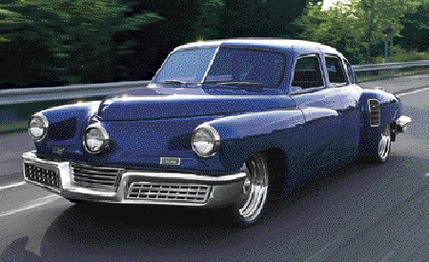
 Specialty File
Specialty File
Some people don't get it," says Bob Ida softly, relaxing behind the wheel of the prototype reproduction Tucker that he and son Rob have constructed in preparation for a production run of, they hope, 50 cars. Surprisingly, many of those who "don't get it" are fans of Ida Automotive's other products, particularly its reproduction supercharged, Chevy-powered '34 Willys street rods-high-end, high-tech rods with custom one-off machined wheels, which even modest, soft-spoken Bob admits is really wild stuff. Street-rod magazines have agreed by awarding them repeated covers.
But the New Tucker 48 is something different and built for another reason, going back, in fact, to 1947, when Bob Ida's father, Joe, and his uncle, Dominick, scraped up enough cash to establish a Tucker dealership in Yonkers, New York. The demise of Tucker is well-known, and although the brothers lost their investments, they didn't lose their faith in Preston Tucker or his cars. Joe was outbid trying to buy a Tucker when the company was dissolved.
Fifty years later, Bob and Rob decided to use the skills and equipment from 35 years in the business of building street rods to build a Tucker for the elder Ida. Original Tucker No. 51, owned and restored by fellow New Jerseyite Chick DeLorenzo, was put in a jig to obtain exact body measurements. Entered into a CAD system, the data were used to make templates for a plug for the body mold for the Tucker replica. The body panels themselves are made from resin-infused plastic, which is more durable than fiberglass and even steel. The taillight housings and the front and rear grilles are all machined from billet aluminum. The fender grilles are cast from the original wood patterns, and the bumpers on the prototype are of the same composite used for the body but are vacuum-chrome-plated. Production models, says Rob, may well have cast and plated aluminum bumpers.
The chassis follows best street-rod practice, with steel rectangular tubes CNC-machined and welded by Rob. The front double-A-arm suspension, machined from billet aluminum, uses standard street-rod geometry. The true Tucker experience-or as close as possible-meant rear-engine configuration. Bob and Rob chose to achieve that by dropping in a complete Cadillac Northstar front subassembly, engine, transmission, and suspension. It's not air-cooled or hung out behind the rear axle as in the original Tucker, but the new, powerful, and reliable drivetrain fits perfectly and offers modern performance.
Liberties were taken with the dash to accommodate air conditioning, and white-face Dolphin street-rod gauges give a proper vintage look. If the drawings can be found, the single-spoke steering wheel Preston Tucker had intended to use will be offered. Otherwise, a replica '41 Lincoln wheel will be used, à la original Tucker.
The front seat is a custom bench, and it feels odd and slinglike at first, but it grows on you. The prototype has a GM steering column with stock GM column shifting, a little stiff on the prototype, but Bob promises better for production. Bob has street-rod muffling on the Cadillac engine, which is to say it's loud inside, but the Caddy V-8 operates as unobtrusively as it should.
When we drove the Tucker, it was equipped with high-profile 255/78-15 wide white-sidewall tires and, we later would learn, a half-inch rear toe-out inadvertently dialed in during some development work. That, combined with the natural 40/60 tail heaviness of the rear-engine configuration, yielded skittish low-speed handling and some rather, um, exciting lane-change dynamics at highway speed. Ida fixed the rear toe and mounted 20-inch aluminum wheels fitted with tires with about two inches of sidewall. That greatly reduced the wobbles, but there's no disguising the weight that still lives between the rear wheels. Does it feel like a Tucker? Dunno. Never drove one, and oddly enough, never has Bob Ida.
It is, surprisingly, a car that one could drive cross-country, despite some wind noise over the top of the split windshield. And it could use some quieter mufflers. More likely, if Bob and Rob can find customers who "get it" to the tune of $150,000, the Tucker 48 will be used for cruising, shows, and other short-haul duties. It's a unique street rod with lots of room-and even seatbelts in back for the kids. Too much money? Bob notes it's not uncommon for custom turnkey street rods to sell for a quarter-million dollars, and none will attract attention, waves, and thumbs up like we got when driving the Tucker.
But despite 10,000 man-hours and $450,000 just to develop the prototype, Bob says it will be worthwhile if they never make another. The prototype, in all its Waltz Blue splendor, was completed before Joe Ida died last summer. That, and enthusiastic support of the Tucker family, would be enough. Bob's life won't change if he doesn't reach the 50 he's set as a limit-Preston Tucker built only 51-as he and his dozen or so employees will also continue to handcraft Willys street rods and other special projects. On the other hand, maybe enthusiasts out there do get it.
Ida Automotive, 600 Texas Road, Morganville, New Jersey 07751; 732-591-1245; www.idaautomotive.com.